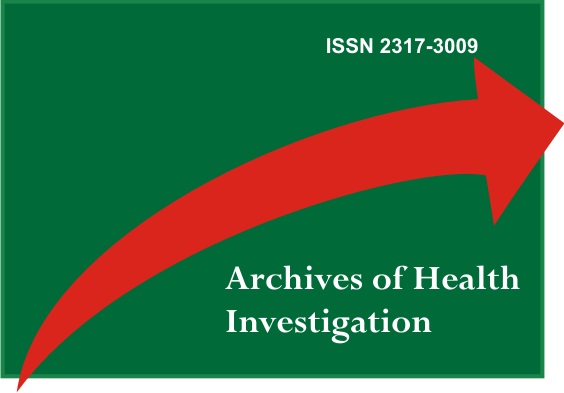Positioning and Tilting of the Glenosphere in Reverse Total Shoulder Arthroplasty and its Impact on Functional Activities in Patients with Rotator Cuff Arthropathy
DOI:
https://doi.org/10.21270/archi.v12i12.6319Keywords:
Glenoid cavity, Arthroplasty, Shoulder, Rotator Cuff Tear ArthropathyAbstract
Background: Reverse shoulder arthroplasty as management of rotator cuff arthropathy has been widely used and studied. Its positioning according to the glenoid inclination component is strictly related to postoperative outcomes. This study aims to evaluate the postoperative outcomes of the glenosphere inclination in patients submitted to reverse shoulder arthroplasty. Methods: a retrospective study of 29 patients submited to reverse shoulder arthroplasty to management of rotator cuff arthropathy. The patients had their glenosphere positioning angle measured, analyzed, and divided into groups according to the degree of inclination. The evaluation included The Constant Score (CS), Subjective Shoulder Value, scapular notching rate classificatied by Sirveaux (2004), and range of movement (ROM). Results: We did not observe any statistical difference between the groups for active anterior elevation (p=0.675; Student's t-test) nor mean active external rotation with the arm adducted (p=0.485; Student's t-test). The group with a lower slope had an CS of 67.94±19.38, and the group with a higher slope had an CS of 81.34±16.16, with no statistical difference (p=0.066). Conclusion: The positioning of the glenoid plate and the inclination of the glenosphere are crucial in the postoperative outcome. However, we did not present a statistical difference in the Functional Score.
Downloads
References
Cheung E, Willis M, Walker M, Clark R, Frankle M. Complications in reverse total shoulder arthroplasty. J Am Acad Orthop Surg. 2011;19:439-449.
Crosby LA, Hamilton A, Twiss T. Scapula fractures after reverse total shoulder arthroplasty: classification and treatment. Clin Orthop Relat Res. 2011;469:2544-2549.
Guery J, Favard L, Sirveaux F, Oudet D, Mole D, Walch G. Reverse total shoulder arthroplasty. Survivorship analysis of eighty replacements followed for five to ten years. J Bone Joint Surg Am. 2006; 88:1742-1747.
Nam D et al. Reverse total shoulder arthroplasty: current concepts, results, and component wear analysis. J Bone Joint Surg Am. 2010;92:23-35.
Scarlat MM. Complications with reverse total shoulder arthroplasty and recent evolutions. Int Orthop 2013;37:843-851.
Walch G et al. Acromial insufficiency in reverse shoulder arthroplasties. J Shoulder Elbow Surg. 2009;18:495-502.
Wierks C, Skolasky RL, Ji JH, McFarland EG. Reverse total shoulder replacement: intraoperative and early postoperative complications. Clin Orthop Relat Res. 2009;467:225-234.
Berhouet J, Gulotta L, Chen X, Dines D, Warren R, Kontaxis A. Neutral glenoid alignment in reverse shoulder arthroplasty does not guarantee decreased risk of impingement. J Orthop Res. 2018;36(4):1213-1219
Bishop J, Kline S, Aalderink K, Zauel R, Bey M. Glenoid inclination: in vivo measures in rotator cuff tear patients and associations with superior glenohumeral joint translation. J Shoulder Elbow Surg. 2009;18:231-236.
Gerber C, Pennington SD, Nyffeler RW. Reverse total shoulder arthroplasty. J Am Acad Orthop Surg. 2009;17:284-295.
11.Hopkins AR, Hansen UN, Amis AA, Emery R. The effects of glenoid component alignment variations on cement mantle stresses in total shoulder arthroplasty. J Shoulder Elbow Surg. 2004;13:668-675.
Konrad G, Markmiller M, Jolly J, Ruter A, Sudkamp N, McMahon P, Debski R. Decreasing glenoid inclination improves function in shoulders with simulated massive rotator cuff tears. Clin Biomech (Bristol, Avon). 2006;21:942-949.
Oosterom R, Rozing P, Bersee H. Effect of glenoid componente inclination on its fixation and humeral head subluxation in total shoulder arthroplasty. Clin Biomech (Bristol, Avon). 2004;19:1000-1008.
Strauss EJ, Roche C, Flurin PH, Wright T, Zuckerman JD. The glenoid in shoulder arthroplasty. J Shoulder Elbow Surg. 2009;18:819-833.
Terrier A, Merlini F, Pioletti D, Farron A. Total shoulder arthroplasty: downward inclination of the glenoid component to balance supraspinatus deficiency. J Shoulder Elbow Surg. 2009;18:360-365.
Maurer A, Fucentese SF, Pfirrmann CW, Wirth SH, Djahangiri A, Jost B, Gerber C. Assessment of glenoid inclination on routine clinical radiographs and computed tomography examinations of the shoulder. J Shoulder Elbow Surg.2012;21:1096-1110.
Boileau P, Gauci MO, Wagner ER, Clowez G, Chaoui J, Chelli M, Walch G. The reverse shoulder arthrosplasty angle: a new measurement os glenoid inclination for reverse shoulder arthroplasty. J Shoulder Elbow Surg. 2019;28(7):1281-1290.
Constant CR et al. A review of the Constant score: modifications and guidelines for its use. J Shoulder Elbow Surg. 2008;17(2):355-361.
Sirveaux F et al. Grammont inverted total shoulder arthroplasty in the treatment of glenohumeral osteoarthritis with massive rupture of the cuff. Results of a multicenter study of 80 shoulders. J Bone Joint Surg Br. 2004;86(3):388-395.
Simovitch RW et al. 2007. Predictors of scapular notching in patients managed with the Delta III reverse total shoulder replacement. J Bone Joint Surg Am. 89:588–600.
Gutierrez S et al. Biomechanical comparison of component position and hardware failure in the reverse shoulder prosthesis. J Shoulder Elbow Surg. 2007;16:S9–S12.
Gutierrez S et al. Range of impingement-free abduction and adduction deficit after reverse shoulder arthroplasty. Hierarchy of surgical and implant-design-related factors. J Bone Joint Surg Am. 2008;90:2606–2615.
de Wilde LF et al. Prosthetic overhang is the most effective way to prevent scapular conflict in a reverse total shoulder prosthesis. Acta Orthop 2010;81:719–726.
Gutierrez S, Walker M, Willis M, Pupello DR, Frankle MA. Effects of tilt and glenosphere eccentricity on baseplate/boné interface forces in a computational model, validated by a mechanical model, of reverse shoulder arthroplasty. J Shoulder Elbow Surg. 2011;20:732–739.
Kempton LB et al. A radiographic analysis of the effects of glenosphere position on scapular notching following reverse total shoulder arthroplasty. J Shoulder Elbow Surg. 2011;20:968–974.
Tashjian RZ et al.. Superior Baseplate Inclination Is Associated With Instability After Reverse Total Shoulder Arthroplasty. Clin Orthop Relat Res. 2018;476(8):1622-1629.
Laver L, Garrigues GG. Avoiding superior tilt in reverse shoulder arthroplasty: a review of the literature and technical recommendations. J Shoulder Elbow Surg. 2014; 23(10):1582-1590.
Li X et al. Effects of glenosphere positioning on impingement-free internal and external rotation after reverse total shoulder arthroplasty. J Shoulder Elbow Surg. 2013;22:807–813.
Nyffeler RW, Werner CM, Gerber C. Biomechanical relevance of glenoid component positioning in the reverse Delta III total shoulder prosthesis. J Shoulder Elbow Surg. 2005;14:524–528.


